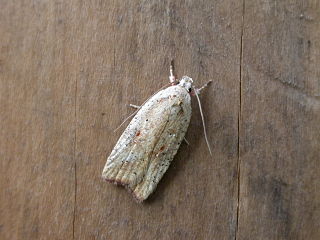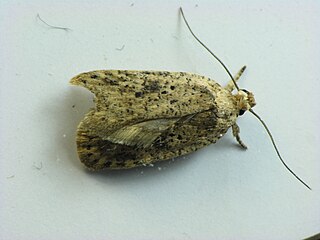
The gorse tip moth is a smallish moth species of the family Depressariidae.
Agonopterix cajonensis is a moth in the family Depressariidae. It was described by John Frederick Gates Clarke in 1941. It is found in North America, where it has been recorded from California.
Agonopterix costimacula is a moth in the family Depressariidae. It was described by John Frederick Gates Clarke in 1941. The Global Lepidoptera Names Index lists it as a synonym of Agonopterix nigrinotella. It is found in North America, where it has been recorded from Maryland, Michigan, Ohio and Ontario.
Agonopterix dimorphella is a moth in the family Depressariidae. It was described by John Frederick Gates Clarke in 1941. It is found in North America, where it has been recorded from South Carolina, Illinois, Nebraska, Kansas and Arkansas.
Agonopterix posticella is a moth in the family Depressariidae. It was described by Walsingham in 1881. It is found in North America, where it has been recorded from Washington to California and in Wyoming and Colorado.
Agonopterix amissella is a moth in the family Depressariidae. It was described by August Busck in 1908. It is found in North America, where it has been recorded from Florida.
Agonopterix nigrinotella is a moth in the family Depressariidae. It was described by August Busck in 1908. It is found in North America, where it has been recorded from Arkansas, Illinois, Indiana, Maine, Maryland, Michigan, Minnesota, New York, Ohio, Ontario, Quebec and Wisconsin.
Agonopterix pergandeella is a moth in the family Depressariidae. It was described by August Busck in 1908. It is found in North America, where it has been recorded from Minnesota and Nebraska.
Agonopterix rosaciliella is a moth in the family Depressariidae. It was described by August Busck in 1904. It is found in North America, where it has been recorded from Alaska and western Saskatchewan through Washington to California and Arizona.
Agonopterix sanguinella is a moth in the family Depressariidae. It was described by August Busck in 1902. It is found in North America, where it has been recorded from Arizona, New Mexico and Nevada.

Agonopterix senicionella is a moth in the family Depressariidae. It was described by August Busck in 1902. It is found in North America, where it has been recorded from Kentucky, Michigan, Ohio, Virginia and West Virginia.
Agonopterix latipalpella is a moth in the family Depressariidae. It was described by William Barnes and August Busck in 1920. It is found in North America, where it has been recorded from Texas.
Exaeretia canella is a moth in the family Depressariidae. It was described by August Busck in 1904. It is found in North America, where it has been recorded from California, Washington, from British Columbia to Quebec, Idaho, Colorado, Montana, Wyoming, Michigan, New Hampshire, New York and Connecticut.
Chionodes psiloptera is a moth in the family Gelechiidae first described by William Barnes and August Busck in 1920. It is found in North America, where it has been recorded from Quebec to British Columbia and then to Alaska, eastern Washington, Montana and New York.
Chionodes retiniella is a moth in the family Gelechiidae first described by William Barnes and August Busck in 1920. It is found in North America, where it has been recorded from Idaho, Wyoming, Nevada, British Columbia, Washington, Colorado, New Mexico, Arizona and California.
Chionodes xanthophilella is a moth in the family Gelechiidae first described by William Barnes and August Busck in 1920. It is found in North America, where it has been recorded from California, Arizona, Nevada, New Mexico, Texas and North Dakota.
Coleotechnites elucidella is a moth of the family Gelechiidae described by William Barnes and August Busck in 1920. It is found in North America, where it has been recorded from California.

Teleiopsis baldiana is a moth of the family Gelechiidae described by William Barnes and August Busck in 1920. It is found in North America, where it has been recorded from California.
Aristotelia lindanella is a moth of the family Gelechiidae. It was described by William Barnes and August Busck in 1920. It is found in North America, where it has been recorded from California.
Gonionota bourquini is a moth in the family Depressariidae. It was described by Clarke in 1964. It is found in Brazil and Argentina.


